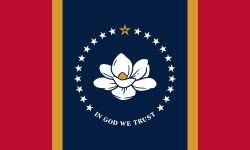
Back Mississippi Afrikaans ሚሲሲፒ Amharic Mississippi AN Mississippi ANG مسيسيبي Arabic ܡܝܣܝܣܝܦܝ ARC ميسيسيپي ARY ميسيسيبى ARZ Mississippi AST Mississippi ATJ
Mississippi | |
|---|---|
| Nickname(s): "The Magnolia State" and "The Hospitality State" | |
| Motto(s): | |
| Anthem: "One Mississippi" | |
 Map of the United States with Mississippi highlighted | |
| Country | United States |
| Before statehood | Mississippi Territory (1798-1817) |
| Admitted to the Union | December 10, 1817 (20th) |
| Capital (and largest city) | Jackson |
| Largest metro | Greater Jackson |
| Government | |
| • Governor | Tate Reeves (R) |
| • Lieutenant Governor | Delbert Hosemann (R) |
| Legislature | Legislature |
| • Upper house | Senate |
| • Lower house | House of Representatives |
| Judiciary | Supreme Court of Mississippi |
| U.S. senators | Roger Wicker (R) Cindy Hyde-Smith (R) |
| U.S. House delegation | 1: Trent Kelly (R) 2: Bennie Thompson (D) 3: Michael Guest (R) 4: Mike Ezell (R) (list) |
| Area | |
• Total | 48,430 sq mi (125,443 km2) |
| • Land | 46,952 sq mi (121,607 km2) |
| • Water | 1,521 sq mi (3,940 km2) 3% |
| • Rank | 32nd |
| Dimensions | |
| • Length | 340 mi (545 km) |
| • Width | 170 mi (275 km) |
| Elevation | 300 ft (90 m) |
| Highest elevation | 807 ft (246.0 m) |
| Lowest elevation | 0 ft (0 m) |
| Population (2024) | |
• Total | |
| • Rank | 35th |
| • Density | 63.5/sq mi (24.5/km2) |
| • Rank | 33rd |
| • Median household income | US$43,567[4] |
| • Income rank | 50th |
| Demonym | Mississippian |
| Language | |
| • Official language | English |
| Time zone | UTC−06:00 (Central) |
| • Summer (DST) | UTC−05:00 (CDT) |
| USPS abbreviation | MS |
| ISO 3166 code | US-MS |
| Trad. abbreviation | Miss. |
| Latitude | 30°12′ N to 35° N |
| Longitude | 88°6′ W to 91°39′ W |
| Website | ms |
| List of state symbols | |
|---|---|
 | |
 | |
 | |
| Slogan | Virtute et armis (Latin) |
| Living insignia | |
| Bird | Northern mockingbird (Mimus polyglottos) |
| Butterfly | Spicebush swallowtail (Papilio troilus) |
| Fish | Largemouth bass (Micropterus salmoides) |
| Flower | Magnolia |
| Insect | Western honey bee (Apis mellifera) |
| Mammal | White-tailed deer (Odocoileus virginianus) |
| Reptile | American alligator (Alligator mississippiensis) |
| Tree | Southern magnolia (Magnolia grandiflora) |
| Inanimate insignia | |
| Beverage | Milk |
| Color(s) | red and blue |
| Dance | Square dance[5] |
| Food | Sweet potato |
| Gemstone | Emerald |
| Mineral | Gold |
| Rock | Granite |
| Shell | Eastern oyster (Crassostrea virginica) |
| Toy | Teddy Bear[6] |
| State route marker | |
 | |
| State quarter | |
 Released in 2002 | |
| Lists of United States state symbols | |
Mississippi (/ˌmɪsɪˈsɪpi/ ⓘ MISS-iss-IP-ee)[7] is a state in the Southeastern region of the United States. It borders Tennessee to the north, Alabama to the east, the Gulf of Mexico to the south, Louisiana to the southwest, and Arkansas to the northwest. Mississippi's western boundary is largely defined by the Mississippi River, or its historical course.[8] Mississippi is the 32nd largest by area and 35th-most populous of the 50 U.S. states and has the lowest per-capita income. Jackson is both the state's capital and largest city. Greater Jackson is the state's most populous metropolitan area, with a population of 591,978 in 2020. Other major cities include Gulfport, Southaven, Hattiesburg, Biloxi, Olive Branch, Tupelo, Meridian, and Greenville.[9]
The state's history traces back to around 9500 BC with the arrival of Paleo-Indians, evolving through periods marked by the development of agricultural societies, rise of the Mound Builders, and flourishing of the Mississippian culture. European exploration began with the Spanish in the 16th century, followed by French colonization in the 17th century. Mississippi's strategic location along the Mississippi River made it a site of significant economic and strategic importance, especially during the era of cotton plantation agriculture, which led to its wealth pre-Civil War, but entrenched slavery and racial segregation. On December 10, 1817, Mississippi became the 20th state admitted to the Union. By 1860, Mississippi was the nation's top cotton-producing state and slaves accounted for 55% of the state population.[10] Mississippi declared its secession from the Union on January 9, 1861, and was one of the seven original Confederate States, which constituted the largest slaveholding states in the nation. Following the Civil War, it was restored to the Union on February 23, 1870.[11] Mississippi's political and social landscape was dramatically shaped by the Civil War, Reconstruction era, and civil rights movement, with the state playing a pivotal role in the struggle for civil rights. From the end of the Civil War to the 1960s, Mississippi was dominated by socially conservative and segregationist Southern Democrats dedicated to upholding white supremacy.
Despite progress, Mississippi continues to grapple with challenges related to health, education, and economic development, often ranking among the lowest in the United States in national metrics for wealth, health care quality, and educational attainment.[12][13][14][15] Economically, it relies on agriculture, manufacturing, and an increasing focus on tourism, highlighted by its casinos and historical sites. Mississippi produces more than half of the country's farm-raised catfish, and is a top producer of sweet potatoes, cotton and pulpwood. Others include advanced manufacturing, utilities, transportation, and health services.[16] Mississippi is almost entirely within the east Gulf Coastal Plain, and generally consists of lowland plains and low hills. The northwest remainder of the state consists of the Mississippi Delta. Mississippi's highest point is Woodall Mountain at 807 feet (246 m) above sea level adjacent to the Cumberland Plateau; the lowest is the Gulf of Mexico. Mississippi has a humid subtropical climate classification.
Mississippi is known for its deep religious roots, which play a central role in its residents' lives. The state ranks among the highest of U.S. states in religiosity. Mississippi is also known for being the state with the highest proportion of African-American residents. The state's governance structure is based on the traditional separation of powers, with political trends showing a strong alignment with conservative values. Mississippi boasts a rich cultural heritage, especially in music, being the birthplace of the blues and contributing significantly to the development of the music of the United States as a whole.
- ^ "Knob Reset". NGS Data Sheet. National Geodetic Survey, National Oceanic and Atmospheric Administration, United States Department of Commerce.
- ^ a b "Elevations and Distances in the United States". United States Geological Survey. 2001. Archived from the original on October 15, 2011. Retrieved October 24, 2011.
- ^ "United States Census Quick Facts Mississippi". Retrieved January 9, 2025.
- ^ "Median Annual Household Income". census.gov. Retrieved January 27, 2020.
 This article incorporates text from this source, which is in the public domain.
This article incorporates text from this source, which is in the public domain.
- ^ "2020 Mississippi Code :: Title 3 - State sovereignty, jurisdiction and holidays :: Chapter 3 - State Boundaries, Holidays, and State Emblems :: § 3-3-39. State dance". Justia Law.
- ^ "3-3-43 - State toy". 2010 Mississippi Code. Justia. Retrieved 31 March 2011.
- ^ "Mississippi". Merriam-Webster.com Dictionary. Merriam-Webster.
- ^ "Meandering Mississippi River". earthobservatory.nasa.gov. July 19, 2020.
- ^ "2020 Population and Housing State Data". Census.gov. Retrieved 2022-02-07.
- ^ "Cotton in a Global Economy: Mississippi (1800-1860) | Mississippi History Now". mshistorynow.mdah.state.ms.us. Archived from the original on June 15, 2019. Retrieved May 24, 2019.
- ^ Richter, William L. (2009). The A to Z of the Civil War and Reconstruction. Lanham: Scarecrow Press. ISBN 9780810863361. OCLC 435767707.
- ^ "Mississippi Annual State Health Rankings—2013". americashealthrankings.org. Archived from the original on April 24, 2016. Retrieved October 5, 2014.
- ^ "Percent of People Who Have Completed High School (Including Equivalency) statistics—states compared—Statemaster". Archived from the original on October 6, 2014. Retrieved October 5, 2014.
- ^ "State Median Household Income Patterns: 1990–2010". U.S. Census Bureau. Retrieved August 6, 2012.
 This article incorporates text from this source, which is in the public domain.
This article incorporates text from this source, which is in the public domain.
- ^ "Sub-national HDI—Subnational HDI—Global Data Lab". globaldatalab.org. Retrieved May 24, 2019.
- ^ Mississippi Rankings and Facts
Cite error: There are <ref group=lower-alpha> tags or {{efn}} templates on this page, but the references will not show without a {{reflist|group=lower-alpha}} template or {{notelist}} template (see the help page).

